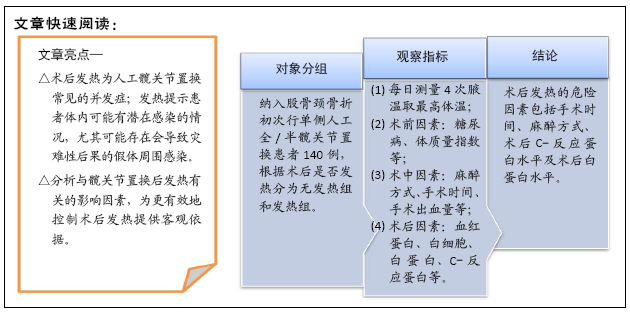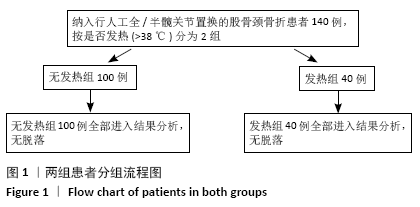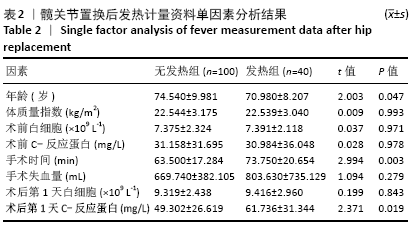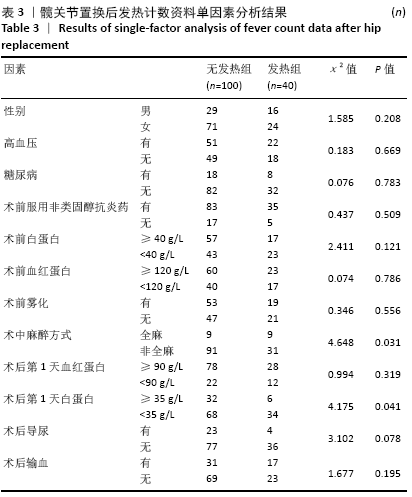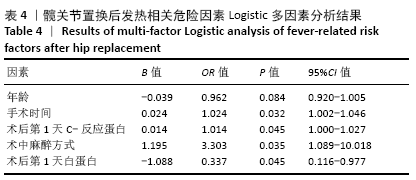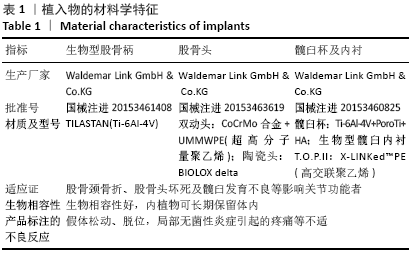[1] ATHANASSIOUS C, SAMAD A, AVERY A, et al. Evaluation of fever in the immediate postoperative period in patients who underwent total joint arthroplasty. J Arthroplasty. 2011;26(8):1404-1408.
[2] CZAPLICKI AP, BORGER JE, POLITI JR, et al. Evaluation of postoperative fever and leukocytosis in patients after total hip and knee arthroplasty. J Arthroplasty. 2011;26(8):1387-1389.
[3] YOO JH, KIM KT, KIM TY, et al. Postoperative fever after hemiarthroplasty in elderly patients over 70 years of age with displaced femoral neck fracture: Necessity of routine workup? Injury. 2017;48(2): 441-446.
[4] ASCIONE T, BALATO G, BOCCIA G, et al. Predictive value of fever following arthroplasty in diagnosing an early infection. Infez Med. 2017;25(1):3-7.
[5] 宋炎成,蔡道章,王昆,等. 膝关节置换术后发热的相关因素分析[J]. 中国矫形外科杂志,2008,16(5):332-333+352.
[6] 许杰,马若凡,丁悦,等. 全膝关节置换后感染的随访分析[J]. 中国组织工程研究与临床康复,2011,15(13):2450-2453.
[7] REZAPOOR M, ALVAND A, JACEK E, et al. Operating Room Traffic Increases Aerosolized Particles and Compromises the Air Quality: A Simulated Study. J Arthroplasty. 2018;33(3):851-855.
[8] OWERS KL, JAMES E, BANNISTER GC. Source of bacterial shedding in laminar flow theatres. J Hosp Infect. 2004;58(3):230-232.
[9] 李艳, 杜金凯. 人工关节置换术的麻醉特点及其并发症[J]. 中国组织工程研究与临床康复,2007,11(36):7244-7247.
[10] 宋斌, 乔永杰, 蒋晧宇, 等. 椎管内麻醉与全身麻醉对关节置换术效果的Meta分析[J]. 临床麻醉学杂志,2017,33(1):52-58.
[11] 谢和宾, 曾鸿, 刘松华, 等. 气管插管全麻术后患者肺部感染危险因素的Meta分析[J]. 中国感染控制杂志,2018,17(6):507-511.
[12] ZHONG H, WANG Y, WANG Y, et al. Comparison of the effect and clinical value in general anesthesia and combined spinal-epidural anesthesia in elderly patients undergoing hip arthroplasty. Exp Ther Med. 2019;17(6): 4421-4426.
[13] YOUNG B, GLEESON M, CRIPPS AW. C-reactive protein: a critical review. Pathology. 1991;23(2):118-124.
[14] MOUTACHAKKIR M, LAMRANI HANCHI A, BARAOU A, et al. Immunoanalytical characteristics of C-reactive protein and high sensitivity C-reactive protein. Ann Biol Clin (Paris). 2017;75(2):225-229.
[15] LU X, JIN J, LIN J, et al. Course of fever and potential infection after total joint replacement. Knee Surg Sports Traumatol Arthrosc. 2015; 23(6):1870-1876.
[16] 梁树军, 徐飞, 宋莺春, 等. 双侧同期全膝关节置换术后发热与血红蛋白关系研究[J]. 现代仪器与医疗,2015,21(1):50-52.
[17] SHEN H, ZHANG N, ZHANG X, et al. C-reactive protein levels after 4 types of arthroplasty. Acta Orthop. 2009;80(3):330-333.
[18] BABIC B, TAGKALOS E, GOCKEL I, et al. C-reactive Protein Levels After Esophagectomy Are Associated With Increased Surgical Trauma and Complications. Ann Thorac Surg. 2020;109(5):1574-1583.
[19] CROSS MB, YI PH, THOMAS CF, et al. Evaluation of malnutrition in orthopaedic surgery. J Am Acad Orthop Surg. 2014;22(3):193-199.
[20] BOHL DD, SHEN MR, KAYUPOV E, et al. Hypoalbuminemia independently predicts surgical site infection, pneumonia, length of stay, and readmission after total joint arthroplasty. J Arthroplasty. 2016;31(1):15-21.
[21] BOHL DD, SHEN MR, HANNON CP, et al. Serum Albumin Predicts Survival and Postoperative Course Following Surgery for Geriatric Hip Fracture. J Bone Joint Surg Am. 2017;99(24):2110-2118.
[22] KAMATH AF, NELSON CL, ELKASSABANY N, et al. Low albumin is a risk factor for complications after revision total knee arthroplasty. J Knee Surg. 2017;30(3):269-275.
[23] SALVETTI DJ, TEMPEL ZJ, GOLDSCHMIDT E, et al. Low preoperative serum prealbumin levels and the postoperative surgical site infection risk in elective spine surgery: a consecutive series. J Neurosurg Spine. 2018;29(5):549-552.
[24] JIAN ZY, MA YC, LIU R, et al. Preoperative positive urine nitrite and albumin-globulin ratio are independent risk factors for predicting postoperative fever after retrograde Intrarenal surgery based on a retrospective cohort. BMC Urol. 2020;20(1):50.
[25] KENNEDY JG, RODGERS WB, ZURAKOWSKI D, et al. Pyrexia after total knee replacement. A cause for concern? Am J Orthop (Belle Mead, NJ). 1997;26(8):549-552,554.
[26] THEMISTOKLIS T, THEODOSIA V, KONSTANTINOS K, et al. Perioperative blood management strategies for patients undergoing total knee replacement: Where do we stand now? World J Orthop. 2017;8(6): 441-454.
[27] 李春亮, 王凯, 严文琪, 等. 人工膝关节置换术后发热特点、趋势及相关因素分析[J]. 重庆医学,2017,46(21):2974-2976.
[28] 魏民, 王琪, 李众利, 等. 替考拉宁联合关节镜清理和关节腔灌洗治疗膝关节感染的疗效观察[J]. 中华医院感染学杂志,2011,21(14): 3026-3028.
[29] WANG D, LUO ZY, YU ZP, et al. The antifibrinolytic and anti-inflammatory effects of multiple doses of oral tranexamic acid in total knee arthroplasty patients: a randomized controlled trial. J Thromb Haemost. 2018;16(12):2442-2453.
[30] 鲁昕, 翁习生, 金今, 等. 人工膝关节置换术后发热特点及趋势的相关分析[J]. 中国骨与关节外科,2013,6(6):501-504.
|
